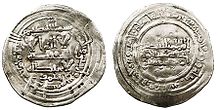Abd ar-Rahman III.

ʿAbd ar-Rahmān III. ( Arabic عبد الرحمن, DMG ʿAbd ar-Raḥmān , Spanish Abderramán ; * 889 ; † October 15, 961 in Córdoba ) was the eighth emir from 912 to 929 and the first caliph of Córdoba from 929 to 961 . His assumption of power and his successful suppression of the rebellion of ʿUmar ibn Hafsūn mark an important turning point in the history of Umaiyad rule in al-Andalus .
As an emir
ʿAbd ar-Rahmān III. was a great-nephew of al-Mundhir and succeeded his grandfather Abdallah (who had ʿAbd ar-Rahmāns father executed) in the Emirate of Córdoba in 912 . At first he succeeded in suppressing several revolts and in 913 the submission of Seville . The insurgent ʿUmar ibn Hafsūn submitted to ʿAbd ar-Rahmān's rule in 915 in return for assurances of impunity and remained loyal to him until his death in 918. ʿAbd ar-Rahmān's approach was made easier by the ensuing power struggles within the Hafsun clan.
After ʿAbd ar-Rahmān had already upgraded the fleet in 914, he first responded in 917 to requests for help from Berber princes in the Maghreb against the Fatimids .
The outbreak of civil war in León (925) also weakened the Muslim rebels in the margravates supported by León. In 928 the Hafsunids had to capitulate in Bobastro , ʿAbd ar-Rahmān had the fortress razed. In the same year the Marwanids of Mérida were subjugated. With the conquest of Toledo , the pacification of the empire could be completed.
As a caliph
On January 16, 929, ʿAbd ar-Rahmān III. the title of caliph and established the Caliphate of Cordoba . This happened, among other things, because he saw himself threatened by the Shiite Fatimids, who also claimed the caliphate for themselves. Anyone else who uses the title “Commander of the Believers” ( amīr al-muʾminīn ) for himself is a deceiver, he let it be publicly declared, which he means to both the Fatimid caliph al-Mahdī (r. 909-934) and the Abbasid Caliph al-Muqtadir (ruled 908-932) said.
In the following years there were also disputes with the Fatimids about supremacy in Morocco . In 931 the coastal cities of Ceuta and Tangier were occupied (Melilla had already been conquered in 927) and turned into fortresses. A further expansion of the Fatimids in Morocco was prevented by alliances with the Berber tribes of the Banu Ifran or Magrawa and the Salihids .
Even against Castile and León , ʿAbd ar-Rahmān III. Assert themselves well in the ongoing battles, including León and Navarra in 920 were defeated. However, he suffered a heavy defeat against León in August 939 in the Battle of Simancas , in which he was wounded and only barely escaped captivity. Nevertheless, in 951 the Umayyads were able to enforce the suzerainty of León, Castile and Barcelona , which led to considerable tribute payments by the Christians. The importance of the Caliphate of Córdoba in the Mediterranean can also be seen in the fact that Byzantium concluded an alliance with the Umayyads against the Fatimids in 946 and Otto the Great also sent a German embassy to Córdoba.
Under ʿAbd ar-Rahmān III. there was a great economic boom after the pacification of the country. This was u. a. favored by the introduction of oriental and Persian irrigation techniques in agriculture and the introduction of silkworm breeding . Long-distance trade in the Mediterranean was also of great importance.
Through the promotion of art, culture and science and a strong construction activity, Córdoba rose to become one of the most important cultural and economic centers in the Mediterranean, alongside Constantinople and Baghdad . Among other things, the Medina Azahara palace city near Córdoba was built under Maslama ibn Abdallah after 936 . ʿAbd ar-Rahmān's favorite, the Christian Marjān, built several mosques and founded pious foundations .
Like his son al-Hakam II , ʿAbd ar-Rahmān III. had a male harem . After the death of ʿAbd ar-Rahmān in October 961, al-Hakam II became Caliph of Cordoba.
literature
- Évariste Lévi-Provençal , Emilio García Gómez (ed.): Una Crónica anónima de Abd al-Rahman III al-Nasir . Madrid 1950, LCCN 55-027295 .
- Maribel Fierro: ʾAbd al-Rahman. The First Cordoban Caliph . Makers of the Muslim World. Oneworld Publications, Oxford 2005, ISBN 1-85168-384-4 .
- Ulrich Haarmann : History of the Arab World . CH Beck, Munich 2004. ISBN 3-406-47486-1 .
- Arnold Hottinger : The Moors. Arab culture in Spain , Wilhelm Fink Verlag, Munich 1995, ISBN 3-7705-3075-6 .
- Stephan Ronart, Nandy Ronart (Ed.): Lexicon of the Arab World. A historical-political reference work. Artemis Verlag, Düsseldorf 1972, ISBN 3-7608-0138-2 .
- Janina M. Safran: Defining Boundaries in al-Andalus: Muslims, Christians, and Jews in Islamic Iberia. Cornell University Press, Ithaca, 2013, ISBN 9780801451836 , pp. 59-69.
Web links
Individual evidence
- ↑ Cf. Safran: Defining Boundaries in al-Andalus 2013, pp. 38–39.
- ↑ See Safran: Defining Boundaries in al-Andalus 2013, p. 64.
- ↑ See Safran: Defining Boundaries in al-Andalus 2013, p. 68.
- ↑ See Safran: Defining Boundaries in al-Andalus 2013, p. 68.
- ↑ See Safran: Defining Boundaries in al-Andalus 2013, pp. 68f.
- ↑ See Alejandro García Sanjuán: Till God Inherits the Earth. Islamic Pious Endowments in al-Andalus (9-15th Centuries). Leiden: Brill 2007. p. 95.
- ↑ E. Michael Gerli (ed.): Medieval Iberia: An Encyclopedia . Routeledge, 2003, p. 397 ( online ).
| predecessor | Office | successor |
|---|---|---|
| Abdallah of Cordoba |
Emir of Córdoba / from 929 Caliph of Córdoba 912–961 |
al-Hakam II |
| personal data | |
|---|---|
| SURNAME | Abd ar-Rahman III. |
| ALTERNATIVE NAMES | عبد الرحمن (Arabic); Abderramán (Spanish) |
| BRIEF DESCRIPTION | Emir and Caliph of Cordoba (912–961) |
| DATE OF BIRTH | 889 |
| DATE OF DEATH | October 15, 961 |
| Place of death | Cordoba |
